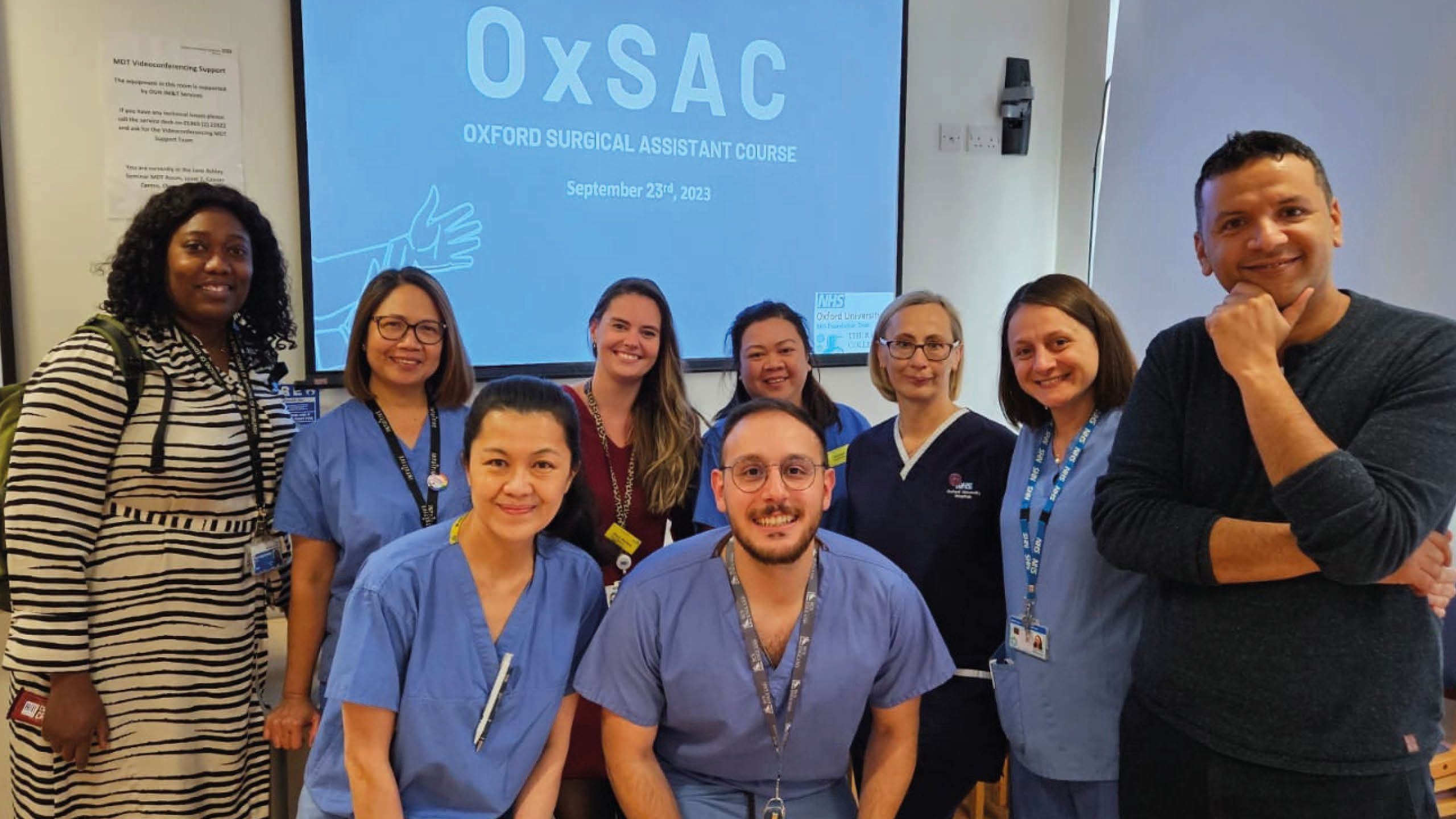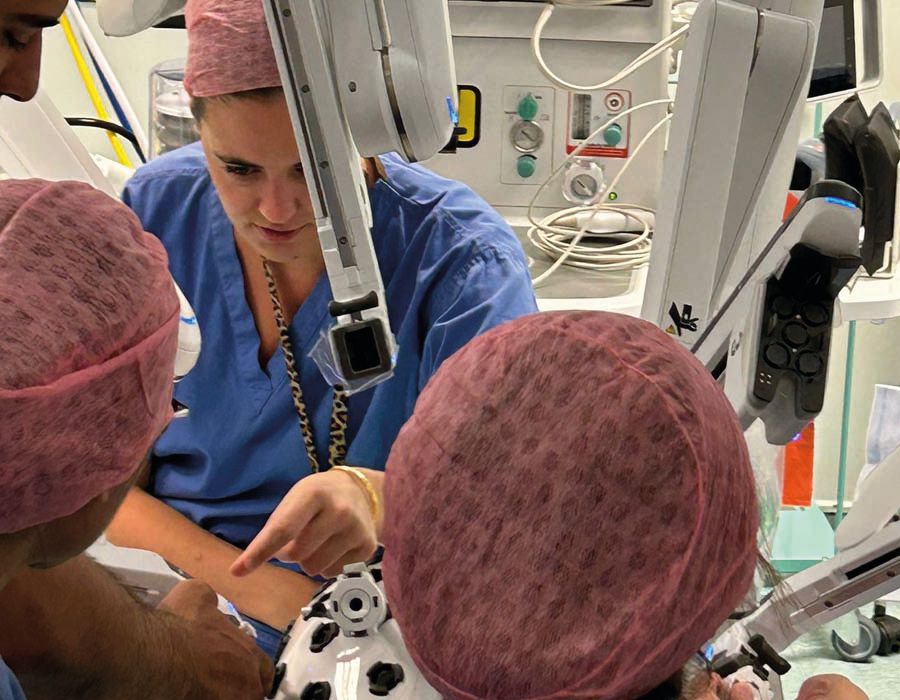Bridging the gap
Focus on Oxford Surgical Assistants Course (OxSAC)


Khalid Adnan Shamiyah
Foundation Year 2 Trainee, Oxford Deanery
The day came quickly, and with a mix of excitement and nerves I entered the operating theatre (OT) to assist on a right hemicolectomy. Once in my surgical attire the reality of my lack of experience hit me. Standing by the operating table, the surgical instruments before me seemed alien. When the leading surgeon asked for assistance I reached out with shaky hands, only to receive a series of instructions from my seniors on what to do next.
I was frustrated as I could not anticipate what was needed of me.
I did not understand my role or the steps of the procedure. The world
of surgical protocols and the use of surgical tools seemed too complex for a beginner. Each step was a reminder of how unprepared I was, yet a step towards gaining familiarity.
The procedure lasted for hours, with each moment a mix of amazement, learning and self-doubt. The patience and expertise of senior nurses and surgeons guided me, correcting and encouraging me along the way. Their level of skill and ease seemed like a distant goal, the pursuit of which I had just begun.
Baby steps
As the operation ended my relief was less about the operation’s success and more about understanding the gap between what I had learned in medical school and what the real surgical world demanded. This experience was more than just a task: it highlighted the need for a structured transition for new doctors from the classroom to the OT.
The journey of a junior doctor towards becoming a proficient surgeon is reminiscent of a child learning to run before they can walk. There’s an eagerness to take on the OT, to be at the forefront of surgical interventions. Akin to how a child must first master the art of balancing, taking cautious steps and enduring falls, a junior doctor must first familiarise themselves with the intricacies of surgical equipment, instruments and the techniques a surgeon must master.
This realisation led to the inception of the Oxford Surgical Assistant Course (OxSAC). It was designed to help junior doctors not only learn the technical skills, but practise and perfect the foundational skills and mental readiness required to assist in surgical procedures competently, before advancing to undertake surgical procedures themselves.

Course overview
OxSAC was designed as a full one-day course divided into an initial welcome and introductory session that led onto three 90-minute hands-on practical workshops.
The workshops were set in a real OT and delivered by a multi-disciplinary team comprising senior surgical trainees and experienced theatre practitioners. This provided a truly encompassing and holistic teaching approach through which participants gained valuable insights from both professionals.
The first station covered the basics of open surgery. These included effective scrubbing, patient draping, and identification and appropriate use of surgical instruments, along with simple suturing and stapling techniques.
The second station delved into laparoscopic surgery, introducing relevant instruments, camera holding and providing hands-on practice to improve handling and coordination. The final station introduced robotic surgery, utilising the da Vinci Surgical System. It included practice sessions on docking and undocking robotic arms, changing instruments and engaging in simulated training exercises to familiarise junior doctors with the robotic surgical interface.
Competitive tasks were carried out in the three workshops as well as an initial surgical quiz that was repeated at the end of the course; prizes were awarded for each.
Participants and feedback
For the first OxSAC, we purposefully limited the number of trainees to enable more focused attention and hands-on opportunities for those attending. A group of 18 participants were split into three smaller groups, rotating around three stations throughout the day. The small group setting facilitated interactive discussions and personalised feedback from the multidisciplinary teaching team, aiming to provide a well-rounded and engaging learning experience for all junior doctors involved.
Post-course feedback from trainees was substantially valuable. Demographically, the participant pool was composed of 65% FY2 and 35% FY1 doctors. The overall experience was rated highly, with 93.8% of participants rating it as excellent and 6.2% as very good.
“Participants expressed a desire for more time at each station to practise and develop their skills”
The robotic workshop emerged as the most interesting station, capturing the interest of 60% of participants. Importantly, all participants acknowledged the benefit from attending the course and expressed a unanimous interest in attending future versions, indicating a strong endorsement of its value.
Additionally, participants offered suggestions that shed light on areas for enhancement. They expressed a desire for more time at each station to further practise and develop their skills, particularly with regards to suturing techniques and closing of skin. These suggestions provide a constructive pathway for improving the course structure and content in future workshops.
Moving forward
Encouraged by the positive feedback from the first course, we are planning to expand the course to other regions in the UK, with several foundation trainee surgical societies already expressing interest. A multi-level course structure is being contemplated, in which junior doctors progress based on acquired competencies. Upon completing course levels, certificates can be provided, serving as proof of competency as surgical assistants.
This evolution aims to equip junior doctors with key surgical assisting skills and exposure to OT etiquette, and to elevate surgical education and practice within the UK. There are also future plans to diversify the course content by introducing specialised modules for other surgical specialties, such as orthopaedics.
Nurturing ground
Much like the cautious initial steps of a child, OxSAC offers junior doctors a nurturing ground to familiarise themselves with the rhythm of the OT environment. Through a structured progression from foundational open surgery techniques to the sophisticated realms of laparoscopic and robotic surgery, OxSAC serves as a vital bridge, filling the gap between theoretical knowledge and practical skills. It contributes to the broader narrative of advancing surgical education, ensuring junior doctors are prepared to become the adept surgeons of tomorrow.
Thanks to Michael Silva, Consultant HPB Surgeon, for nurturing this idea and facilitating logistic support from the RCSEd and providing invaluable feedback. Gratitude is also extended to Marta Penna, Senior Surgical Trainee, and Lian Lee, Deputy Matron, for their support and expert opinions. Thank you to the Faculty members for facilitating the stations and our sponsors – the RCSEd, Oxford University Hospitals, LawMed, and Ethicon – for their support.
Watch the OxSAC trainee video below.

